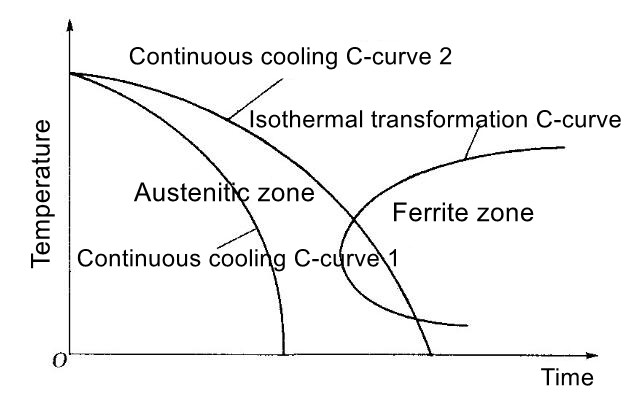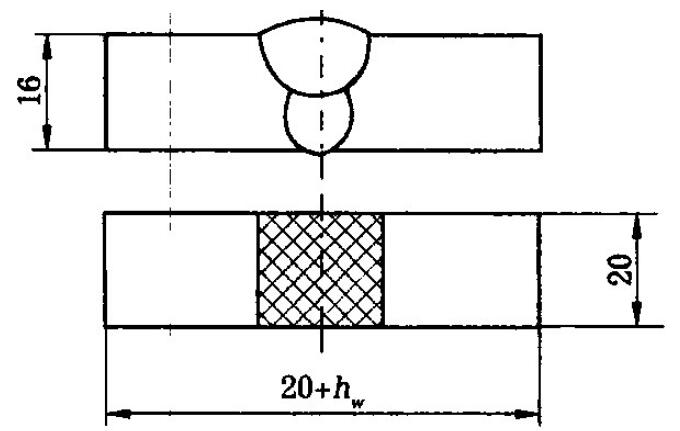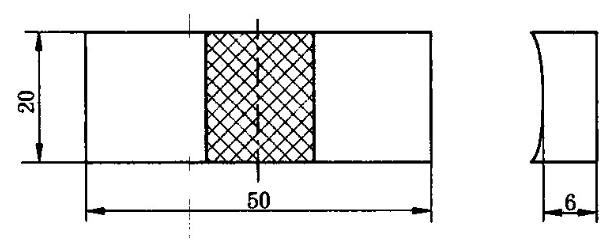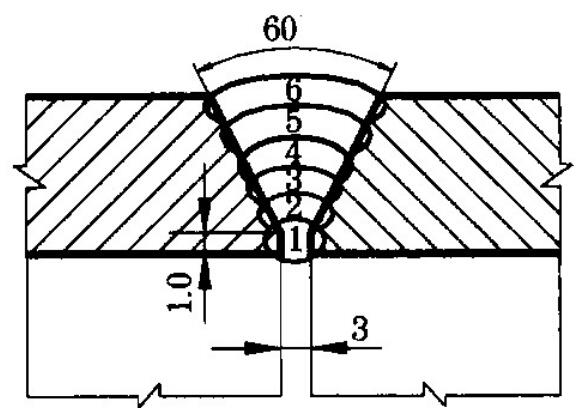The 316L Mod Urea ultra-low carbon stainless steel material and its welding requirements are introduced, which are used in urea equipment operating in high temperatures, high pressures and highly corrosive media. The key to welding technology is that the welded joint has excellent weld crack resistance and intergranular corrosion resistance. Based on the qualification of the welding process, a reasonable on-site welding process for products has been developed, including the selection of welding materials, the design of groove shape and size, welding specification parameters, problems and solutions in the welding process. welding. Practice has proven that strict control of the entire product welding process can achieve excellent welding quality.
1. Introduction
316L Mod stainless steel with ultra-low carbon urea is an improved material in accordance with the US AISI standard, grade 316L. It is an austenitic-ferritic duplex stainless steel due to its excellent resistance to hot cracking during welding and intergranular corrosion. It is widely used as a material for high pressure pipelines in urea petrochemical plants. Urea equipment with high temperature, high pressure, flammable, explosive, corrosive and other characteristics, maximum operating pressure of 15MPa, maximum operating temperature of 385°C, main working medium for methylamine, urine, liquid ammonia and other highly corrosive. Stainless steel material has strong intergranular corrosion ability. Welding 316L Mod stainless steel with ultra-low carbon is the key to the entire device. Technical difficulties, good technical management, reasonable welding process and complete process control guarantee the welding quality.
2. Technical requirements of materials
2.1 Technical requirements for the base material
Urea corrosion resistance of stainless steel materials by Hugh test for evaluation should have excellent resistance to highly corrosive media such as methylamine liquid and urine produced by intergranular corrosion. When the carbon content is less than 0.03%, the stainless steel in the sensitized state, in the sensitization temperature range of 450-850 °C, the precipitation of Cr 23 C 6 significantly reduced, with excellent resistance to intergranular corrosion. The material in the austenite-forming elements (Ni, C, N, Mn) and ferrite-forming elements (Cr, Mo, Si) must be balanced so that the weld metal in the weld is completely austenitic and the maximum ferrite content of according to the Schaeffler diagram for calculations is 0.6% and is limited to the range in Table 1. The use of higher chromium content in the base material may cause the stainless steel surface to form a dense oxide film and improve corrosion resistance, such as: B. 00Cr17Ni14Mo2N, whose main size specifications are Φ168.3×16, Φ60.3×8.8, Φ273.1×25.5 etc., the chemical composition is shown in Table two.
Table 1 Chemical composition of the stainless steel urea device, range of values (mass fraction)
| element | W | Cr | No | Mo | N |
| Content | ≤0.030 | ≥17.0 | ≥13. 0 | ≥2.2 | ≤0.20 |
Table 2 Chemical composition of 316L Mod (00Cr17Ni14Mo2N) (mass fraction) %
| element | W | Cr | No | Mo | Yes | Mn | s | P | N |
| Content | 0.03 | 17.3 | 13.6 | 2.53 | 0.45 | 1.78 | 0.001 | 0.022 | 0.19 |
2.2 Technical requirements and selection of welding consumables
Welding consumables must meet all technical requirements of the base metal of the molten metal. Considering the loss of alloying elements and the complexity of the weld cooling method, controlling the ferrite content of the weld metal needs to shift the C curve of the isothermal transformation of austenite to the right. A higher alloying element content, especially a higher Ni content, can cause the C curve of the isothermal transformation of austenite to be shifted to the right, so that the organization of austenite is more stable in the weld cooling process and reduce the chance of the austenite transforming into a ferrite becomes organization. Welding consumables with a higher alloy content than the base metal were selected and the welding wire R25.22.2LMN, Φ1.6, and the welding rod BM310MoL or E25.22.2LMNB, Φ2.5, Φ3.2 were used. Chemical compositions are listed in Table 3 and Table 4.
Table 3 Chemical composition of welding wire R25.22.2LMN
| element | W | Cr | No | Mo | Yes | Mn | s | P | N |
| Content | 0.014 | 24.99 | 21.69 | 2.64 | 0.17 | 4.43 | 0.001 | 0.012 | 0.13 |
Table 4 Chemical composition % of the BM310MoL electrode (mass fraction )
| element | W | Cr | No | Mo | Yes | Mn | s | P | N |
| Content | 0.03 | 24.54 | 02/21 | 2.32 | 0.45 | 4.43 | 0.004 | 0.02 | 0.12 |
Before welding and welding process, they should be checked for ferrite content, ferrite content of all unqualified base metals, welding consumables and their contact with the metal material . It is strictly prohibited to bring it into the building.
3. Welding Technology Requirements for 316L Ultra Low Carbon Mod Stainless Steel
3.1 Prevent carburization and reduce corrosion resistance
At room temperature, the solubility of carbon in austenite is about 0.02%-0.03%, when the austenitic carbon content exceeds its solubility at room temperature, the carbon constantly diffuses to the austenitic grain boundaries and the Chromium and chromium compounds form Cr 23 C 6 chromium carbide precipitates whereby the austenite boundary becomes poor in chromium and, as a corrosive medium, leads to intergranular corrosion, which reduces corrosion resistance.
Due to the high temperature, weld beads and oil on the surface of the weld metal, a large amount of carbon can be generated during welding and penetrate the weld bead. Therefore, strict control of the carbon source is necessary.
3.2 Avoid weld cracks
As a result of alloying elements Si, B, Ni and impurity elements, a low-melting liquid intermediate layer S, P, can produce the formation of low-melting eutectic in the weld pool, Si and Ni to Ni 3S 2 melting point is 645℃, Ni-Ni 3S 2 eutectic melting point is only 625°C. The thermal conductivity of austenitic stainless steel is low, the coefficient of linear expansion is large, the internal stress during welding is large, and hot cracking is easy, resulting in welding defects of austenitic stainless steel, especially in stainless steel welding austenitic. Especially with single-phase austenitic stainless steel, errors are more likely to occur.
To avoid welding cracks, it is necessary to strictly control the content of S, P, etc. of welding parts and welding consumables, reduce heat input and improve the cooling rate and structure of welded joints to reduce the degree of restriction.
3.3 Control of ferrite content
Due to methylamine, the corrosion characteristics of urine are mainly total corrosion and selective erosion, and the organization of ferrite promotes the development of selective erosion. Therefore, the corrosion performance of methylamine urine is better in pure austenitic organization, so the ferrite content must be strictly controlled.
For this purpose, contact of stainless steel base material, welding consumables and carbon steel material should be strictly avoided. Special stainless steel corundum grinding wheels must be used to grind the connections. When welding, a lower welding line power should be used and the interlayer temperature should not exceed 60 °C. The welding temperature must not remain too high during welding and there must be no intersection of the continuous cooling austenitic C curve and the austenitic isothermal transformation. This ensures that the weld metal has a uniform austenitic structure.
Figure 1: The austenitic continuous cooling C 1 curve is obtained from the minor weld line energy curve, and the austenitic continuous cooling C 2 curve is obtained from the weld line excess energy curve. As the weld line energy increases, the weld cooling time increases and the austenitic continuous cooling C-curve shifts to the right. In the Continuous Cooling Austenitic C-Curve, the Isothermal Transformation Austenitic C-Curve does not intersect with the Isothermal Transformation Austenitic C-Curve before the weld metal is finally fully organized austenitic. As the weld line energy continues to increase, the austenitic continuous cooling C curve shifts further to the right, the austenitic continuous cooling C curve meets the austenitic isothermal transformation C curve, and the final organization of the metal Welding of the molten metal has a ferritic organization. 
Figure 1: Diagram of the C curve of the austenite transformation
4. Evaluation of the welding process
Welding process evaluation in accordance with JB 4708-92 “Welding process evaluation for steel pressure vessels” of the relevant provisions of welding process evaluation for stainless steel 316L Mod. Record welding current, welding voltage , power supply polarity, welding consumables, specifications, argon gas flow on both sides, etc. for tensile and bending test, Hewitt test, metallurgical test and ferrite test. And the ferrite test.
4.1 Welding process selection
The element content of 316L Mod ultra-low carbon stainless steel alloy is high, and the media contact side is welded using a TIG welding process under inert gas. For thick-walled materials, considering production and economic efficiency, lower argon arc welding and upper arc welding are used as argon electric welding methods. The welding process parameters are listed in Table 5.
Table 5: Welding process parameters
| Sweat level | Welding process | Welding material quality and specification | Energy polarity | Welding current/A | Welding voltage/V | Welding speed/mm.s -1 | Argon flow rate/L.Min -1 |
| 1-2 | TIG | 25.22.2LMN Φ1.6 | DC SP. | 90-110 | 12-14 | 1.0 to 1.2 |
Positive: 8-12 Back: 10-15 |
| 3 | SMAW | BM310MoL Φ2.5 | DCRP. | 65-75 | 21-24 | 1.0 to 1.2 | |
| 4-5 | SMAW | BM310MoL Φ4.0 | DCRP. | 110-130 | 23-26 | 1.7 to 1.9 | |
| 6 | SMAW | BM310MoL Φ2.5 | DCRP. | 65-75 | 21-24 | 1.0-1. two |
Note: The control line energy for the welding process is generally less than 25 kJ/cm.
4.2 Sample preparation
- (1) Preparation of the tensile test and flexural test in accordance with the provisions of JB 4708-92 “Evaluation of the welding process for steel pressure vessels”.
- (2) Preparation of metallographic sample (ferrite determination sample): The metallographic sample should include the weld, the heat-affected zone and the base material of three areas. The sample size is shown in Figure 2.
- (3) Hugh sample preparation: Since two welding processes are used, that is, argon arc welding, filling and covering arc welding, the sample preparation should include two molten metal welding processes. Samples must be taken from the side that comes into contact with the medium; the pipe must be removed from the inner wall to test its corrosion resistance more accurately. The pre-processing sample must be removed from the material by sawing and shearing, and then mechanically planed or milled. The use of the grinding method is not permitted. The deformation before processing should be as small as possible, the cutting amount should be limited to less than 2 mm and 0.1-0.3 mm. The material of the cutting tool for finishing the sample should be high-speed steel, the last 1mm of the sample should have a planing depth of 0.6mm, 0.3mm and 0.1mm or 0.05-0.1mm and the cutting speed cutting should be 4-10 m/min. Hugh sample surface area is 20 to 30 cm 2 Sample surface 20 to 30 cm 2 and sample surface 20-10mm. The surface area of Hugh's sample is 20 to 30 cm 2 ; Sample preparation is shown in Figure 3.

Figure 2: Metallographic sample diagram 
Fig.3 Copy of Hugh
4.3 Assessment results
(1) Welded connections are qualified based on their visual appearance and a 100% RT II test standard.
(2) The tensile and flexural test results are listed in Table 6.
Table 6: Test results of the mechanical properties of welded joints
| Project | σb / MPa | Breaking point | Result |
| Traction test | 650 | Broken weld | Qualified |
| Traction test | 670 | Broken weld | Qualified |
| Lateral bending test | Qualified |
(3) The results of the metallurgical organization test are as follows: The organization of the base material for single-phase austenitic organization is distributed in a strip shape along the rolling direction. Grain uniformity, fine, local twinning, particle size 7-8. Welding organization for austenitic matrix + a small amount of dendritic ferrite, measured, the ferrite content is less than 0.6%. The organization of the heat-affected zone is the same as the base material, slightly enlarged. There is a good organization; the evaluation results are qualified.
(4) Ferrite determination results are listed in Table 7.
Table 7: Ferrite measurement results
| Test site | standard | Actual measurement results |
| Base material | ≤ 0.6% | Qualified |
| Heat affected zone | ≤ 0.6% | Qualified |
| Weld | ≤ 0.6% | Qualified |
(5) Hugh test results: After five cycles, each cycle subjected to a 48-hour boiling nitric acid corrosion test (Hugh test), the test results for a series of properties were confirmed; see Table 8 and Table 9.
Table 8 Boiling nitric acid corrosion test (Hugh test) gives 1
| Weekly corrosion rate (48 hours) μm | ||||||
| cycle | 1 | two | 3 | 4 | 5 | Average |
| Pattern<3 | <3 | <3 | <3 | <3 | <3 | |
| Actual measurement | 2.28 | 1.83 | 1.44 | 1.24 | 1.14 | 1.59 |
Note: 1,3,5,7 for base material perpendicular to the rolling direction of the part; 4.8 for base material running along the rolling direction; 2.4 for welding.
Table 9 Boiling nitric acid corrosion test (Hugh test) gives 2
| Selective corrosion test results (maximum corrosion depth on each side) μm | ||||||||
| position | 1 | two | 3 | 4 | 5 | 6 | 7 | 8th |
| standard | <70 | <200 | <70 | <200 | <70 | <200 | <70 | <200 |
| Actual measurement | <40 | <40 | <40 | <40 | <40 | <40 | <40 | <40 |
Note: 1,3,5,7 for the rolling direction of the part perpendicular to the base material; 4.8 for the base material along the rolling direction of the part; 2.4 for welding.
5. Welding Procedures
5.1 Requirements for the welding process
5.1.1 Environmental control
Strict environmental controls must be carried out when welding ultra-low carbon 316L Mod Urea stainless steel. Special prefabrication areas must be installed to take measures against wind and rain, as well as special processing tools and handling equipment. Argon arc welding is not permitted at wind speeds above 0.5 m/s; Manual arc welding is not permitted at wind speeds above 3.0 m/s.
5.1.2 Storage and distribution of welding materials
A rigorous management program for the storage, drying, distribution and recycling of welding materials is implemented on construction sites in accordance with international standards ISO 9001:2000. The entire process of storage, distribution, use and recycling of welding materials is controlled. Welding consumables are stored according to brand number and specifications, arranged on shelves and clearly labeled. The welder completes the welding supplement document, the welding technology manager checks it, the welding quality assurance engineer confirms the signature, and the administrator receives individual approval. Welding rods must be dried according to the specified drying temperature. The welding rods obtained must be used to isolate the cylinder, and the same isolated cylinder must not be mixed with different welding rods.
5.1.3 Material removal and chamfer processing
The material of local pipes must be taken into consideration with regard to the requirements for assembly of welded joints. Chamfering of 316L Mod Urea Ultra Low Carbon stainless steel pipe must be done with a drill or beveling machine, and other mechanical methods are not allowed. Plasma cutting, gas cutting or carbon arc planing are not permitted. The thermal conductivity of 316L Mod stainless steel is low, the coefficient of linear expansion is large, and the smaller size chamfer angle and grouping reduce welding deformation. The shape of the chamfer can be found in Figure 4. 
Figure 4: Chamfer production diagram
5.2 Preparation for welding
- (1) Before bundling, the ferrite content, welding wire and chamfer must be checked, and the inner and outer 30mm area must be cleaned of oil, grease, water and other contaminants and wiped with acetone.
- (2) Clean chamfer, grind welds and other applications with stainless steel brushes, corundum grinding wheels and other special tools.
- (3) Welders must wear clean protective work clothes, welding gloves, etc., to avoid contamination.
5.3 Measures related to the welding process
- (1) When welding with higher line power, the grain size becomes slightly coarser and the residual stress increases. At the same time, the rightward shift of the C curve from continuous cooling of austenite leads to an increase in the ferrite content and ultimately reduces the corrosion resistance of welded joints, which directly affects the fluid resistance of the product methylamine and urine corrosion performance. Therefore, the narrow channel, multi-layer, multi-channel welding method should be used as much as possible, using low line power input, short arc, no oscillation or small pendulum, and fast welding method.
- (2) When welding, the quality of the weld must be guaranteed. It is necessary to ensure that the back of the molten metal does not oxidize. The back must always be protected from argon. The argon arc welding process is used to weld the base layer and the second layer.
- (3) For wall thicknesses less than 8mm, ultra-low carbon 316L Mod Urea stainless steel is manufactured by argon arc welding. For wall thicknesses greater than 8mm, 8mm is removed from the root by argon arc welding, and the above part is done manually by arc welding. If the welding filling height is greater than 10 mm, a multi-layer and multi-channel rapid welding process is used. The welding process must ensure that the temperature between the layers does not exceed 60°C.
- (4) When welding, cleanliness and protection must be considered to prevent carburization. In multi-pass welding, each welding pass must be completely free of slag and, once the test has passed, the next pass must be welded. Multipass welding must be carried out in a staggered manner. When soldering, an unused wire that has burned out due to oxidation must be removed before soldering again.
5.4 Welding test
Pipe diameter ≤ 40 mm, check the last weld seam for appearance and ferrite content. Pipe diameter > 40mm, pipe wall thickness ≤ 5mm, check the last weld seam for appearance and ferrite content, penetration test, RT test. Pipe diameter > 40 mm, pipe wall thickness > 5 mm, argon arc welding for priming and welding of the first layer, checking appearance and ferrite content, penetration test, e.g. B. No defects, clean the chamfered surface with acetone, clean after welding the second layer. After welding the second layer, penetration test, if there are no defects, RT test. After final welding, appearance and penetration tests are carried out, as well as RT testing.
The ferrite content is determined using a probe-type ferrite meter and the maximum content must be less than 0.6%. To ensure test accuracy, calibration samples, probes, and solders are cleaned with acetone before testing. The testing process frequently cleans the probe and removes oil and rust.
5.5 Welding repair
After testing, unqualified weld seams must be reworked. Defective parts that can be removed using a mechanical grinding process should not be machined with carbon arc gas planes to avoid carburization. Before repairs, a penetration test must be carried out to confirm that defects have been corrected. Rework is carried out by argon arc welding. The same part of the rework should not be carried out more than twice. Otherwise, the reasons must be analyzed, measures developed and approved by the person responsible for technology.
6. Conclusion
- (1) The welding process evaluation results show that the choice of type 25.22.2LMN wire and type BM310MoL electrode, the use of argon arc welding at the bottom and arc welding with upper layer welding, and the welding 316L stainless steel Mod Urea steel with ultra-low carbon content is possible in the process.
- (2) Through strict control of the ferrite content of the base material and welding consumables, the multi-layer multi-channel short arc, rapid and vibration-free welding, the reduction of line power input, the control of interlayer temperature and other measures of the welding process, and the control of the entire welding process, the quality of the welded structures is made of urea stainless steel in the urea petrochemical plant in the piping system. All welds are qualified by 100% RT and determination of ferrite content.

























































